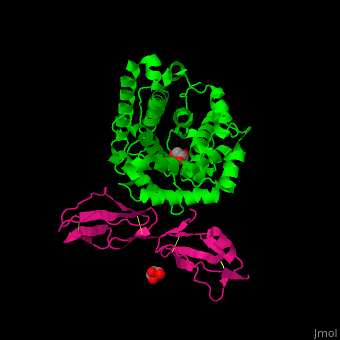Complement factor
From Proteopedia
(Difference between revisions)
| Line 3: | Line 3: | ||
== Function == | == Function == | ||
| - | '''Complement factor H''' (CFH) regulates the complement system which is part of the immune response. CFH protects cells by preventing the activation of the complement system when it is not needed. CFH contains 20 short consensus repeats (sushi domains, i.e., a 5 strand β-sandwich arrangement) | + | '''Complement factor H''' (CFH) regulates the complement system which is part of the immune response. CFH protects cells by preventing the activation of the complement system when it is not needed. CFH contains 20 short consensus repeats (sushi domains, i.e., a 5 strand β-sandwich arrangement)<ref>PMID:15163532</ref>. '''Complement factor D''' (CFD) and '''Complement factor B''' (CFB) regulate a key step in the activation of the alternative complement pathway. CFD is a member of the chymotrypsin family of serine proteases. '''Complement factor I''' (CFI) is a serum protease that inhibits all complement pathways. |
== Disease == | == Disease == | ||
| - | CFH mutations are involved in dense deposit disease, age-related macular degeneration, atypical hemolytic-uremic syndrome, schizophrenia, stroke and the kidney disorder glomerulonephritis. | + | CFH mutations are involved in dense deposit disease, age-related macular degeneration, atypical hemolytic-uremic syndrome, schizophrenia, stroke and the kidney disorder glomerulonephritis. CFD and CFI are implicated in age-related macular degeneration<ref>PMID:22003108</ref>, <ref>PMID:25352734</ref>. |
== Relevance == | == Relevance == | ||
| - | CFH is recruited by human pathogens resulting in increased virulence. | + | CFH is recruited by human pathogens resulting in increased virulence. CFB is a novel target for treatment of cardiometabolic disease<ref>PMID:28739975</ref>. |
== Structural highlights == | == Structural highlights == | ||
Revision as of 08:24, 15 April 2018
| |||||||||||
3D structures of complement factor
Updated on 15-April-2018
References
- ↑ Rodriguez de Cordoba S, Esparza-Gordillo J, Goicoechea de Jorge E, Lopez-Trascasa M, Sanchez-Corral P. The human complement factor H: functional roles, genetic variations and disease associations. Mol Immunol. 2004 Jun;41(4):355-67. PMID:15163532 doi:10.1016/j.molimm.2004.02.005
- ↑ Stanton CM, Yates JR, den Hollander AI, Seddon JM, Swaroop A, Stambolian D, Fauser S, Hoyng C, Yu Y, Atsuhiro K, Branham K, Othman M, Chen W, Kortvely E, Chalmers K, Hayward C, Moore AT, Dhillon B, Ueffing M, Wright AF. Complement factor D in age-related macular degeneration. Invest Ophthalmol Vis Sci. 2011 Nov 11;52(12):8828-34. doi: 10.1167/iovs.11-7933. PMID:22003108 doi:http://dx.doi.org/10.1167/iovs.11-7933
- ↑ Alexander P, Gibson J, Cree AJ, Ennis S, Lotery AJ. Complement factor I and age-related macular degeneration. Mol Vis. 2014 Sep 13;20:1253-7. eCollection 2014. PMID:25352734
- ↑ Coan PM, Barrier M, Alfazema N, Carter RN, Marion de Proce S, Dopico XC, Garcia Diaz A, Thomson A, Jackson-Jones LH, Moyon B, Webster Z, Ross D, Moss J, Arends MJ, Morton NM, Aitman TJ. Complement Factor B Is a Determinant of Both Metabolic and Cardiovascular Features of Metabolic Syndrome. Hypertension. 2017 Jul 24. pii: HYPERTENSIONAHA.117.09242. doi:, 10.1161/HYPERTENSIONAHA.117.09242. PMID:28739975 doi:http://dx.doi.org/10.1161/HYPERTENSIONAHA.117.09242

